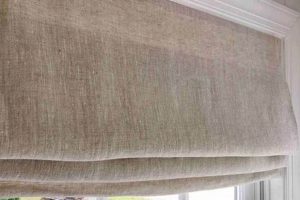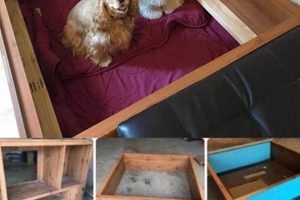The construction of mirrored spheres using readily available materials for decorative and reflective purposes represents a popular craft project. This undertaking typically involves affixing small, reflective squares to a spherical base, often resulting in a shimmering, light-scattering ornament. For example, individuals might use styrofoam balls, tiles of mirrored glass or plastic, and adhesive to create a personalized version of this classic decorative item.
The appeal of creating such items stems from their cost-effectiveness compared to commercially produced versions, as well as the opportunity for personalization and creative expression. Historically, these reflective ornaments have been associated with dance and entertainment venues, contributing to a vibrant and celebratory atmosphere. The creation of personalized versions allows for tailored aesthetics suitable for various settings and preferences.
The following discussion will explore various methods for constructing these reflective ornaments, considerations for selecting appropriate materials, and techniques for ensuring a durable and visually appealing final product. Safety precautions during the construction process will also be addressed, along with potential applications beyond purely decorative uses.
Construction and Enhancement Tips for Mirrored Spheres
The following guidelines provide essential advice for optimizing the construction and aesthetic appeal of homemade mirrored spheres. Adherence to these recommendations enhances the final product’s durability and visual impact.
Tip 1: Base Selection. Choose a spherical base appropriate for the intended scale of the project. Styrofoam or plastic spheres are common choices, offering varying levels of density and impact resistance. Consider the overall weight the sphere will bear once tiles are applied.
Tip 2: Tile Preparation. Precise cutting of mirrored tiles is critical. Employ a glass cutter and appropriate safety equipment to ensure uniformity and prevent injury. Pre-cut mirrored tiles are available but may limit customization options.
Tip 3: Adhesive Application. Select an adhesive specifically formulated for bonding glass or plastic to the base material. Thoroughly research adhesive properties to ensure compatibility and long-term bond strength. Avoid adhesives that may dissolve or react negatively with the base material.
Tip 4: Tile Placement. Apply tiles systematically to the sphere’s surface. Maintain consistent spacing between tiles for a visually appealing and uniform appearance. Consider using a template to aid in consistent placement.
Tip 5: Grout Application (Optional). For enhanced aesthetics and gap-filling, consider applying grout between the tiles. Select a grout color that complements the tiles and thoroughly clean any excess grout from the tile surfaces after application.
Tip 6: Hanging Mechanism. Ensure the hanging mechanism is securely attached and capable of supporting the sphere’s weight. Metal hooks or durable wire are suitable options. Verify the attachment point on the sphere is adequately reinforced.
Tip 7: Reflective Optimization. Test the sphere’s reflective properties under various lighting conditions. Minor adjustments to tile angles may enhance light dispersion and create a more dynamic visual effect.
Consistent application of these techniques will yield a superior, more durable, and visually striking reflective sphere.
The subsequent section will provide a comprehensive review of appropriate lighting solutions to maximize the visual impact of the completed mirrored sphere.
1. Adhesive Bond Strength
Adhesive bond strength is a critical factor in the successful construction and longevity of a mirrored sphere. Insufficient bond strength can lead to tile detachment, compromising the aesthetic integrity and structural soundness of the finished item. Proper adhesive selection and application are therefore paramount.
- Material Compatibility
The adhesive must be chemically compatible with both the sphere’s base material (e.g., styrofoam, plastic) and the mirrored tiles. Incompatible adhesives may fail to bond effectively, leading to premature detachment, or may even damage the base or tile material through chemical reactions. For instance, certain solvents in adhesives can dissolve styrofoam, rendering the bond ineffective.
- Environmental Resistance
The adhesive must maintain its bond strength under varying environmental conditions, including temperature fluctuations and humidity. Some adhesives become brittle or lose adhesion in cold temperatures, while others may soften or degrade in high humidity. Consider the intended environment of the mirrored sphere when selecting an adhesive, especially if it will be used outdoors or in a humid location.
- Application Technique
Proper adhesive application is essential for maximizing bond strength. This includes ensuring that both surfaces are clean and free of dust or grease before application. Applying the adhesive in a thin, even layer, and allowing it to cure fully according to the manufacturer’s instructions, are also crucial. Insufficient adhesive or improper curing can significantly weaken the bond.
- Long-Term Durability
The adhesive’s long-term durability is a key consideration. Adhesives that degrade over time can lead to gradual tile detachment, diminishing the sphere’s appearance and potentially creating a safety hazard. Select an adhesive with a proven track record of long-term performance and resistance to degradation factors such as UV exposure or oxidation.
Therefore, selection and diligent implementation of adhesive for the mirrored sphere is not merely a procedural step, but a significant investment into the durability, safety, and enduring aesthetic charm of the completed item. The interrelation of adhesive and material is what binds the longevity of a mirrored sphere together.
2. Tile Reflectivity Index
The Tile Reflectivity Index (TRI) constitutes a critical performance metric directly influencing the light dispersion and visual impact of a mirrored sphere. A higher TRI signifies a greater proportion of incident light reflected by the tile surface, resulting in brighter, more intense reflections. This attribute is particularly pertinent to mirrored sphere applications, where the objective is to maximize light scattering and create a dynamic, visually stimulating environment. For example, spheres constructed with tiles possessing a low TRI will exhibit diminished brilliance and a less pronounced visual effect compared to those utilizing high-TRI tiles.
The TRI dictates the efficiency with which a sphere transforms a single light source into a multitude of shimmering points, emulating the characteristic “disco ball” effect. Consi
der two identical spheres, one clad in tiles with a TRI of 0.9 (reflecting 90% of incident light) and the other in tiles with a TRI of 0.5 (reflecting 50% of incident light). Under identical illumination, the former will generate a noticeably brighter and more expansive array of reflected light patterns. The selection of tiles with an optimized TRI is therefore essential to achieving the desired aesthetic outcome.
Understanding the TRI enables informed material selection, bridging the gap between theoretical specifications and practical application. Although factors such as tile size, shape, and placement also contribute to the overall visual effect, the TRI serves as a fundamental determinant of the sphere’s reflective capabilities. Ignoring this metric can lead to a final product that fails to meet expectations, underscoring the importance of prioritizing tile reflectivity during the construction process. The sphere’s overall brilliance is directly proportional to this metric.
3. Base Material Durability
The structural integrity of a “diy disco ball” is directly contingent upon the durability of its base material. The base serves as the foundational framework upon which the reflective tiles are affixed. Its capacity to withstand gravitational forces, potential impacts, and environmental stressors determines the longevity and overall stability of the finished decorative piece. Inadequate base material durability can manifest in various forms of structural failure, including deformation, cracking, or complete collapse, ultimately compromising the integrity of the mirrored surface and rendering the item unusable.
For example, a “diy disco ball” constructed using a low-density styrofoam base is susceptible to damage from even minor impacts, potentially resulting in tile dislodgement and permanent structural impairment. Conversely, a base composed of high-density plastic or reinforced fiberglass offers significantly enhanced resistance to physical stress, extending the lifespan of the “diy disco ball” and preserving its aesthetic appeal. The choice of base material therefore dictates the resilience of the structure, influencing its suitability for different applications and environments. If constructed for use within a commercial setting, a more durable material will significantly improve its longevity.
In conclusion, base material durability is a non-negotiable consideration in the creation of a reliable and visually enduring “diy disco ball”. Selection should be predicated upon a thorough assessment of anticipated stresses and environmental conditions to ensure the structure maintains its form and reflective properties over an extended period. Compromising on base material durability inevitably leads to premature failure, negating the time and resources invested in the construction process. Understanding this interconnection between base material durability and a mirrored sphere is paramount to effective design and implementation.
4. Hanging Mechanism Security
The secure suspension of a mirrored sphere is paramount to its safe and effective operation. The hanging mechanism is the critical interface between the decorative item and its surrounding environment, and its failure can lead to significant consequences.
- Load Capacity Assessment
Prior to installation, a thorough assessment of the hanging mechanism’s load capacity is essential. This involves determining the precise weight of the completed mirrored sphere, including the base material, tiles, adhesive, and any internal components. The selected hanging hardware, such as hooks, chains, or cables, must possess a certified load rating that substantially exceeds the sphere’s total weight to account for dynamic loads and potential stress concentrations. Failure to accurately assess and accommodate the sphere’s weight can result in catastrophic failure of the suspension system.
- Material Selection and Compatibility
The materials used in the hanging mechanism must be compatible with both the sphere’s attachment point and the supporting structure from which it is suspended. Galvanic corrosion, for instance, can occur when dissimilar metals are in contact, leading to accelerated degradation and weakening of the connection. Similarly, the chemical compatibility of the hanging hardware with the surrounding environment must be considered, particularly in corrosive or high-humidity settings. Stainless steel or other corrosion-resistant materials are often preferred in such applications.
- Installation Integrity
Proper installation of the hanging mechanism is crucial for ensuring its long-term security. This involves employing appropriate installation techniques, such as drilling pilot holes, using anchors designed for the specific supporting structure, and tightening all connections to the manufacturer’s specified torque. Visual inspection of all connections is necessary to verify proper seating and alignment. Periodic inspections should be conducted to identify any signs of loosening, corrosion, or wear.
- Redundancy and Safety Factors
Implementing redundancy in the hanging mechanism enhances its overall safety and reliability. This can be achieved by using multiple suspension points or employing safety cables that act as a backup in the event of primary suspension failure. Incorporating a safety factor, such as selecting hardware with a load rating significantly higher than the anticipated weight, provides an additional margin of safety and reduces the risk of failure due to unforeseen circumstances.
In conclusion, the security of the hanging mechanism is a non-negotiable aspect of “diy disco ball” construction and installation. Rigorous adherence to established engineering principles and safety protocols is essential to mitigate the risk of failure and ensure the continued safe operation of the decorative item. Prioritizing safety and taking these elements into consideration will help ensure the longevity of the hanging system in operation.
5. Light Dispersion Pattern
The light dispersion pattern emanating from a mirrored sphere is a direct consequence of its geometric design and reflective surface properties. This pattern defines the visual experience created by the device, dictating the distribution, intensity, and aesthetic qualities of the reflected light. Understanding the factors influencing this pattern is crucial for optimizing the design and construction of such spheres.
- Tile Facet Angle Variance
Variations in the angle of individual tile facets significantly impact the dispersion pattern. A uniformly aligned array of tiles will produce a more concentrated and directional reflection, whereas random or intentionally varied facet angles will yield a broader, more diffused dispersion. The selection of facet angle variance depends on the desired aesthetic effect, with higher variance resulting in a more dynamic and scattered pattern.
- Surface Reflectivity and Specularity
The reflective properties of the tile surface, encompassing both reflectivity (the proportion of incident light reflected) and
specularity (the degree to which the reflection is mirror-like versus diffuse), play a fundamental role in shaping the light dispersion pattern. Higher reflectivity yields a brighter and more intense pattern, while greater specularity results in sharper, more defined reflections. Surface imperfections or coatings can reduce specularity, leading to a softer, more diffused effect. - Light Source Characteristics
The characteristics of the light source illuminating the mirrored sphere, including its intensity, color temperature, and beam angle, directly influence the resulting dispersion pattern. A high-intensity light source will generate a brighter and more pronounced pattern, while a light source with a narrow beam angle will produce a more concentrated and directional effect. Adjusting the light source characteristics is a common technique for fine-tuning the sphere’s visual impact.
- Environmental Light Absorption
The absorptive properties of surrounding surfaces indirectly affect the light dispersion pattern by reducing light levels and altering the relative intensities of different areas within the pattern. Surfaces with high light absorption, such as dark-colored walls, will diminish the overall brightness of the pattern and may accentuate the contrast between illuminated and shadowed areas. Understanding these effects is essential for optimizing the placement and orientation of the mirrored sphere within its intended environment.
The manipulation of the light dispersion pattern, through careful consideration of these multifaceted elements, permits precise control over the visual experience generated by a mirrored sphere. By thoughtfully selecting tile properties, facet arrangements, and light source characteristics, one can tailor the sphere to specific aesthetic preferences and environmental conditions, maximizing its impact and ensuring a visually compelling outcome.
Frequently Asked Questions
This section addresses common inquiries regarding the construction of mirrored spheres, offering insights into best practices and potential challenges.
Question 1: What is the optimal adhesive for affixing mirrored tiles to a styrofoam sphere?
Selection should prioritize adhesives specifically formulated for bonding glass or plastic to polystyrene foam. Products labeled as “foam-safe” are essential to prevent dissolution of the styrofoam base. Cyanoacrylate-based adhesives (super glue) are generally unsuitable due to their potential to degrade styrofoam.
Question 2: What safety precautions are necessary when cutting mirrored tiles?
Eye protection, such as safety glasses or goggles, is paramount to prevent injury from flying shards. The use of gloves is recommended to protect hands from cuts. A dedicated glass cutting tool should be employed, and the work area should be adequately ventilated.
Question 3: How can consistent tile spacing be achieved on a curved surface?
A pre-drawn grid on the sphere’s surface can serve as a guide for tile placement. Alternatively, thin spacers, such as cardboard shims, can be temporarily inserted between tiles during the adhesive curing process. These spacers are removed once the adhesive has set.
Question 4: What factors influence the light dispersion pattern of a mirrored sphere?
The size and shape of the tiles, the spacing between tiles, the reflectivity of the tile surface, and the intensity and angle of the light source all contribute to the light dispersion pattern. Smaller tiles and tighter spacing generally produce a more diffused pattern.
Question 5: How can the weight of a mirrored sphere be minimized?
Utilizing a lightweight base material, such as a hollow plastic sphere, and selecting thin, lightweight mirrored tiles can significantly reduce the overall weight. Minimizing the amount of adhesive used is also a contributing factor.
Question 6: What hanging mechanism is recommended for a substantial mirrored sphere?
A robust hanging mechanism, such as a heavy-duty chain or cable, is essential. The mechanism must be securely anchored to both the sphere and the supporting structure. The load rating of the hanging mechanism should exceed the weight of the sphere by a significant margin.
Careful consideration of these questions and adherence to recommended practices will improve the likelihood of a successful and safe mirrored sphere construction project.
The following section will delve into advanced techniques for enhancing the aesthetic appeal of mirrored spheres, including the incorporation of lighting elements and customized tile designs.
Conclusion
The preceding exploration of “diy disco ball” construction has underscored the multifaceted nature of this undertaking. Successful creation requires careful consideration of material selection, adhesive properties, structural integrity, hanging mechanism security, and light dispersion characteristics. Mastery of these elements is essential for achieving a visually compelling and structurally sound final product. Emphasis has been placed on safety, durability, and aesthetic optimization to ensure a positive project outcome.
The construction of a “diy disco ball” represents not merely a craft project, but an exercise in applied design principles. Whether employed for decorative purposes, artistic expression, or functional lighting, adherence to established best practices will maximize the longevity, safety, and visual impact of this reflective ornament. Further research and experimentation within these defined parameters will undoubtedly yield innovative approaches and enhanced aesthetic results. The insights provided herein serve as a foundation for continued exploration and refinement within the field of “diy disco ball” construction.







